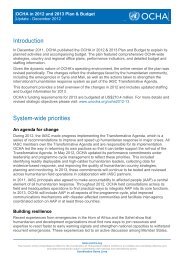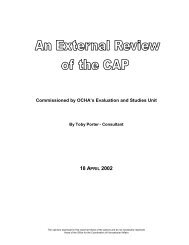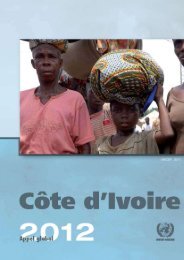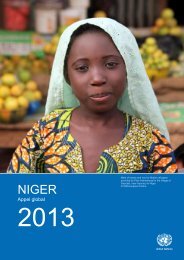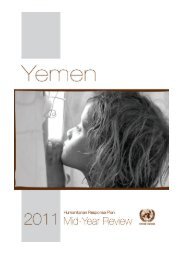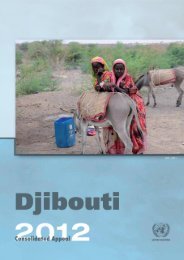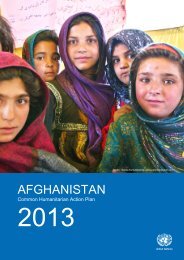SUDAN
United Nations and Partners Work Plan 2013
United Nations and Partners Work Plan 2013
- No tags were found...
Create successful ePaper yourself
Turn your PDF publications into a flip-book with our unique Google optimized e-Paper software.
United Nations and Partners[4] Sector Response Plans<strong>SUDAN</strong> WORK PLAN 201365not available to deeper field locations, and where servicesexist their reliability is often poor and their compliance withmaintenance and safety regulations cannot be guaranteed.As seen throughout 2012, there remains a steady demandfor humanitarian air services with the number of passengersstanding at approximately 4,000 per month, which is expectedto remain the same during 2013. The passenger projectionis built on the current demand statistics and an increase innumbers is expected if South Kordofan and Blue Nile statesbecome accessible to international humanitarian assistance.Emergency TelecommunicationsThe UN and partners’ security telecommunications infrastructurein Sudan was established during 2003/4. In Sudan, thisinfrastructure has been operated and maintained by WFP andis covered by existing inter-agency cost shares. The EmergencyTelecommunications Sector will provide data connectivityand security telecommunications services, as well as usertraining when new emergencies occur and where gaps appear– for example, if there is a new emergency in a new location orLOGISTICS177MT of air freight carried byUNHAS (Jan-Sep 2012)LOGISTICS32,770passengers carried by UNHAS(Jan-Sep 2012)in an existing location without sufficient telecommunicationsinfrastructure.Risk analysisThe Logistics and Emergency Telecommunications (LET)Sector identifies the following risks to implementation of thisresponse plan:• Worsening security: to be mitigated by strict implementationof minimum operating safety standards, prepositioning,and increased use of air operations.Overview of sector objectives, outcomes, outputs and indicators (Logistics and Emergency Telecommunications)Objectives Outcomes Outputs Indicators (with corresponding targets)LOGISTICS and UNHAS1• Coordinated, predictable, timely and efficientlogistics response under the sector approach;information management products supportthe operational decision-making process;uninterrupted delivery of life-saving reliefitems to the affected population on behalf ofthe humanitarian community, according to theneeds and service requests received by thehumanitarian community.• Organise and chair regular Inter-Agency Logistics Coordinationmeetings.• Issue and circulate logistics informationmanagement products on aregular basis.• Organise and conduct regular logisticsassessment missions.• Provide common logistics services tothe humanitarian community.• Number of Inter-Agency Logistics Coordinationmeetings held (12).• Number of information management productsshared, such as maps, sitreps, bulletins, snapshots,dashboard, procedures, meeting minutes (40).• Number of joint operations and assessmentsconducted to enhance the effectiveness of thehumanitarian response (3).• Number of organisations served (UNHAS / Logistics)(150/10).• Number of passengers (40,000).• Number of destinations reached (60).• Quantity (MT) of humanitarian cargo moved by air /land (300/10,000).• Number of service request forms processed vsreceived (60/60).EMERGENCY TELECOMMUNICATIONS (ET)2• Coordinated, predictable, timely and efficient • Organise and chair regular Inter-ET response under the sector approach; Agency ET Coordination meetings.information management products support the• Issue and circulate ET informationoperational decision-making process.management products on a regularbasis.• Organise and conduct regular ETassessment missions.• Standard operating procedures (SOPs)developed/implemented.• Number of Inter-Agency ET Coordination meetingsheld.• Number of information management productsshared, such as project plans, sitreps, maps ofservices, standard operating procedures and meetingminutes.• Number of operations and assessments conductedto enhance the effectiveness of the humanitarianresponse.• COMCENs staff properly trained on standardcommunications procedures.34• All humanitarian staff given comprehensivetraining in all aspects of security telecommunicationsequipment and radio procedures.• HF and VHF frequencies accorded to thestandard UN frequency, channel and callsignallocation plan for the humanitarian community.• Capacity and equipment available to providetemporary services in one emergency location.• International radio trainer providinghumanitarian staff with radio trainingand procedures.• Common radio frequencies and/orlicences issued by the governmentregulatory telecoms authority in place.• Establish a contingency plan andstrategically preposition stock for oneemergency location.• Number of UN and NGO staff trained on securitytelecoms and radio communication procedures.• Common radio frequencies and/or licences issued bythe government regulatory telecoms authority.• Country contingency plan including ET componentto support one new location.




